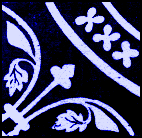
The medieval church 3
A pattern emerges
The creation of new parishes
During the twelfth and thirteenth centuries the parochial map
of Wales was drawn and the parish with its priest, glebe lands
and tithes was at the centre of Welsh ecclesiastical life. In
some parts of Norman controlled Wales - around Brecon, for example
- the newly created parishes were small in size and  reflected the newly created manors
and knight’s fees. Elsewhere new parishes were created by
sub-dividing areas previously under the influence of a native
monastic foundation. Some of these clasau were disbanded
by their new overlords while others were reduced to the status
of parish churches. Many of these new livings were bestowed on
the new monasteries. Although the pattern being created was very
much that to be found in England and indeed across Northern Europe,
a great many of the bishops driving these changes forward were
Welsh and a great many of the local priesthood would have been
native. As local Welsh lords began to support houses of the new
orders, so native Welsh monasticism dwindled. The Augustinian
Canons in particular, supported by the princes of Gwynedd and
Powys, took over several of the clasau of north Wales
and converted them into Augustinian houses.
reflected the newly created manors
and knight’s fees. Elsewhere new parishes were created by
sub-dividing areas previously under the influence of a native
monastic foundation. Some of these clasau were disbanded
by their new overlords while others were reduced to the status
of parish churches. Many of these new livings were bestowed on
the new monasteries. Although the pattern being created was very
much that to be found in England and indeed across Northern Europe,
a great many of the bishops driving these changes forward were
Welsh and a great many of the local priesthood would have been
native. As local Welsh lords began to support houses of the new
orders, so native Welsh monasticism dwindled. The Augustinian
Canons in particular, supported by the princes of Gwynedd and
Powys, took over several of the clasau of north Wales
and converted them into Augustinian houses.
The growth of the Cistercian order
By 1200 the native traditions were drawing to a close.
As time went by, the new orders were seen less as an alien system
forced on Wales, and the Cistercian order, very much a part of
the great European monastic revival, became very successful,
with nine foundations by 1201 which were either Welsh or in Welsh
controlled areas.
There are 5 main pages on the medieval church in Wales. Use the box links below to view the other pages.